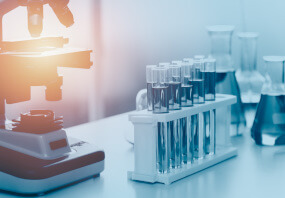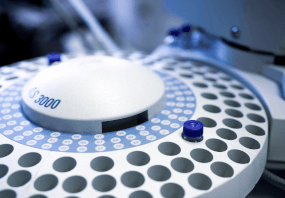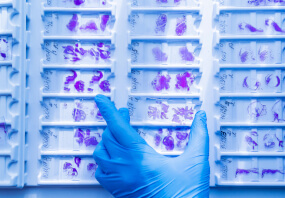General description
Pro-neuregulin-2, membrane-bound isoform (UniProt P56974; also known as Pro-NRG2) is encoded by the Nrg2 gene (Gene ID 100042150) in murine species. The ErbB4 receptor is widely expressed in GABAergic interneurons and reply on the engagement of neuregulins (NRGs) as ligands for signaling during neural processes in the adolescent and adult central nervous system (CNS). NRG1 transcript is generally lower than NRG2 in postnatal CNS and NRG2 is a major functional ErbB4 ligand in the postnatal brain. NRGs are synthesized as single-pass transmembrane pro-forms that is posttranslationally converted to signalling ligands by extracellular sheddases. The presence of an extracellular immunoglobulin (Ig)-like domain allows NRG1/2 ectodomain to accumulate near the site of cleavage through interactions with extracellular matrix heparan proteoglycans. NMDARs are required to release the NRG2 ectodomain from the surface of interneuron cell bodies. Stimulation of ErbB4 by the NRG2 ectodomain not only promotes the internalization of ion channels from the cell surface, but also the association of ErbB4 with GluN2B-containing NMDARs, resulting in a rapid downregulation of NMDARs on inhibitory interneurons, but not pyramidal neurons.
Specificity
Clone 8D11 epitope lies within neuregulin-2, which corresponds to the extracellular domain of membrane-bound pro-neuregulin-2.
Immunogen
Recombinant mouse mature Neuregulin-2.
Application
Anti-Neuregulin-2 (NRG2), clone 8D11, Cat. No. MABN1853, is a highly specific mouse monoclonal antibody that targets Neuregulin-2 (NRG2) and has been tested in Immunocytochemistry, Immunofluorescence, and Immunohistochemistry (Paraffin).
Immunocytochemistry Analysis: A representative lot detected somatodendritic pro-NRG2 puncta on the surface of cultured rat hippocampal ErbB4+ interneurons (DIV 21 & 28) fixed with 4% paraformaldehyde without permeabilization (Vullhorst, D., et al. (2015). Nat. Commun. 6:7222).
Immunofluorescence Analysis: A representative lot detected NRG2 immunoreactivity among ErbB4+ interneurons in CA1 strata pyramidale and radiatum of 4% paraformaldehyde-fixed, 0.25% Triton X-100-permeabilized rat brain sections (Vullhorst, D., et al. (2015). Nat. Commun. 6:7222).
Research Category
Neuroscience
Quality
Evaluated by Immunohistochemistry in human cerebellum tissue sections.
Immunohistochemistry Analysis: A 1:50 dilution of this antibody detected Purkinje cells surface Neuregulin-2 (NRG2) immunoreactivity in human cerebellum tissue sections.
Target description
80.30/67.13/70.64 (human pro-neuregulin-2 isoform 1/DON-1B/DON-1R), 32.60/19.43/22.94 (human neuregulin-2 isoform 1/DON-1B/DON-1R), 80.17/80.04 kDa (mouse pro-neuregulin-2 isoform NRG2-16A/DON-1M), 32.66/32.53/34.24/28.66 kDa (mouse neuregulin-2 isoform NRG2-16A/DON-1M/DON-1S (NRG2-5)/NRG2-10), 80.79/79.84/79.97/79.01/28.63/34.34/79.96 kDa (rat pro-neuregulin-2 isoform NTAK-alpha1/NTAK-alpha2A/NTAK-alpha2B (NTAK-alpha2-1P)/NTAK-beta/NTAK-gamma/NRG2-alpha/NRG2-beta), 33.46/32.50/32.63/31.67/28.63/34.34/32,63 kDa (rat neuregulin-2 isoform NTAK-alpha1/NTAK-alpha2A/NTAK-alpha2B (NTAK-alpha2-1P)/NTAK-beta/NTAK-gamma/NRG2-alpha/NRG2-beta) calculated.
Physical form
Format: Purified
Protein G purified.
Purified mouse IgG1κ in buffer containing 0.1 M Tris-Glycine (pH 7.4), 150 mM NaCl with 0.05% sodium azide.
Storage and Stability
Stable for 1 year at 2-8°C from date of receipt.
Other Notes
Concentration: Please refer to lot specific datasheet.
Disclaimer
Unless otherwise stated in our catalog or other company documentation accompanying the product(s), our products are intended for research use only and are not to be used for any other purpose, which includes but is not limited to, unauthorized commercial uses, in vitro diagnostic uses, ex vivo or in vivo therapeutic uses or any type of consumption or application to humans or animals.
- UPC:
- 51141596
- Condition:
- New
- Availability:
- 3-5 Days
- Weight:
- 1.00 Ounces
- HazmatClass:
- No
- MPN:
- MABN1853












